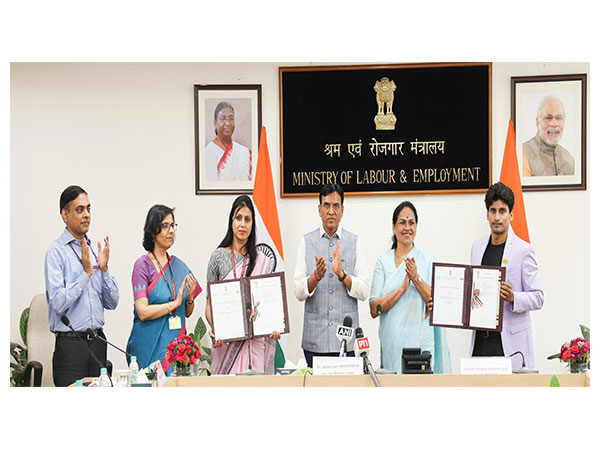STEM Dreams Cut Short: 59 percent Girls Blame Financial Barriers
Apr 29, 2025

NewsVoir
Bengaluru (Karnataka) [India], April 29: A new report, Unlocking Potential: Financial Aid as a Catalyst for Girls' STEM Success, reveals that 59% of girls cite financial constraints as the primary reason for not pursuing STEM education beyond secondary school. The study conducted by Sattva Consulting in collaboration with AISECT, highlights how the high cost of science education, limited scholarship accessibility, and lack of female role models prevent millions of girls in India from entering STEM fields.
The study employed a mixed-methods research approach, combining quantitative surveys and qualitative interviews to understand the financial barriers preventing girls from pursuing STEM education. A total of 4,763 girls from government schools across four states--Rajasthan, Punjab, Jharkhand, and Madhya Pradesh were surveyed for the study. In addition to student surveys, the research incorporated interviews with teachers, parents, school principals, STEM experts, and policymakers to assess the broader systemic challenges.
Despite 80% of future jobs requiring STEM skills, only 39% of girls graduate from higher secondary education in science disciplines. The report highlights stark regional disparities, with over 60% of girls in Tamil Nadu, Telangana, and Andhra Pradesh opting for STEM subjects, while in states like Rajasthan, Punjab, and Jharkhand, participation remains critically low at less than 25%. Owing to the low percentage of girls passing grade 12th in science streams, these states were chosen as the study area, with Madhya Pradesh being the only outlier despite being in a similar geography.
Siddharth Chaturvedi, Director of AISECT, emphasised the importance of addressing these challenges. "We commissioned this report to better understand the systemic barriers preventing girls from entering STEM fields. While discussions around gender equality in education have gained momentum, financial constraints remain an overlooked challenge. By identifying key gaps, we hope this report will drive meaningful interventions that ensure STEM education is accessible for all girls."
The study also highlights the significant gap in scholarship utilization. While Rs. 651.9 crores were allocated across 143 scholarship schemes in 2023-24, 55% of funds remain unspent due to low awareness, complex application processes, and eligibility criteria that exclude economically marginalized students.
The report challenges the traditional one-size-fits-all approach to financial aid and introduces a persona-driven model that maps financial needs to girls' competencies and aspirations. It identifies four distinct beneficiary profiles--Trailblazers, Sustainers, Aspirers, and Disengaged--each requiring tailored financial interventions. High-potential Trailblazers need sustained support to pursue STEM degrees, while Aspirers may benefit more from vocational pathways aligned with STEM careers. Based on this framework, the financial investment required ranges from Rs. 22,000 to Rs. 1,50,000 per girl per year, depending on the pathway and persona. Through this approach, the study makes a case for result-based funding where the financial support is cognizant of the financial needs of different kinds of students.
Additionally, the lack of female role models in STEM further exacerbates the issue, with only 13% of the surveyed schools having female science teachers. Beyond financial aid, the report points to the absence of structured career guidance and vocational pathways for girls to enter the STEM workforce. Many students are unaware of alternative STEM careers beyond engineering and medicine, limiting their aspirations. Without targeted interventions, these barriers will continue to deter young women from pursuing science education and careers.
Dr. Shweta Gaur, Principal Researcher at Sattva Consulting, stressed the need for systemic reform to support girls in STEM. "STEM education is not just about tuition fees. The financial burden extends to coaching, study materials, lab access, and even transport, making it an unattainable goal for many. If we want to bridge the gender gap in STEM, we need solutions that go beyond scholarships. Schools, policymakers, and the private sector must work together to provide sustained financial aid with a long-term commitment, accessible career guidance, and mentorship programs that keep girls engaged in science education."
Rathish Balakrishnan, Co-founder & Partner at Sattva Consulting, echoed this sentiment, emphasizing the need for a shift in financial aid structures. "The solution lies in rethinking the design of financial aid for girls. Funders need to double down on their efforts in the needy states, be patient funders, and invest in girls based on their needs and provide targeted, result-based funding, enabling girls to enter the STEM workforce. He also emphasised the use of technology to scale the reach of the financial support.
The report urges state and national education policymakers to reassess financial aid structures and increase awareness of existing scholarships. It also highlights the role of CSR and philanthropic organizations in bridging the gap through long-term investments in vocational STEM pathways, digital skilling initiatives, and teacher training programs.
Sattva Consulting is an Indian-origin global impact consulting firm. Our work spans 25 countries and 5 continents as we engage with communities, businesses and governments to deliver societal impact at scale since 2009. We believe that Civil society, Business, and Government all have a critical role to play in building an equitable and sustainable world, and we actively partner with all stakeholders to enable impact through our research & advisory services, knowledge platforms and collaborative initiatives.
AISECT, an Indian social enterprise, has been driving skill development, higher education, financial inclusion, and e-governance in semi-urban and rural areas since 1985. Headquartered in Bhopal, it operates across 605 districts, 2,100 blocks, and 8,550 Panchayats in 29 states and 4 territories through a network of 31,000+ centers and offices. AISECT's self-sustaining and scalable model has trained 26 lakh people, created over 100,000 jobs, and improved the lives of 50 lakh individuals, fostering entrepreneurship and digital empowerment in remote communities.
For more information, please visit aisect.org.
(ADVERTORIAL DISCLAIMER: The above press release has been provided by NewsVoir. ANI will not be responsible in any way for the content of the same)




















